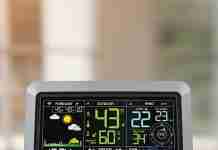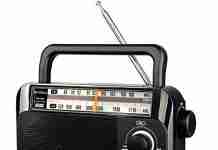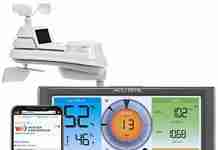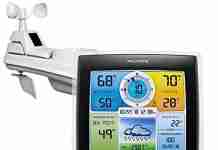Want to make sure your home weather station is giving you accurate temperature and humidity readings? We’ve got you covered! In this article, we’ll share some tips and tricks to help you ensure the reliability of your weather station’s measurements. From proper sensor placement to regular maintenance, we’ll guide you through the steps to keep your weather readings on point. So, grab a cup of coffee and let’s dive in!
Review contents
Positioning the Weather Station
Choosing an appropriate location
When setting up your home weather station, one of the most important factors to consider is choosing an appropriate location. It’s essential to find a spot that is representative of the surrounding area and not influenced by specific conditions. Ideally, the weather station should be placed in an open area, away from any obstacles or obstructions that could interfere with airflow and temperature readings.
Avoiding direct sunlight
Sunlight can significantly impact temperature readings, leading to inaccurate data. Therefore, it is crucial to avoid placing your weather station in direct sunlight. Direct exposure to the sun can cause temperature readings to be higher than the actual ambient air temperature. To achieve accurate results, position the weather station in a shaded area, such as under a tree or an awning.
Avoiding sources of heat or cold
To ensure accurate temperature readings, it is important to avoid placing the weather station near any sources of heat or cold. Nearby heat sources like air conditioning units, vents, or radiators can cause temperature readings to be artificially high. Likewise, placing the weather station in close proximity to cold surfaces or drafts can result in lower-than-actual temperature readings. Choose a location that is away from such sources to obtain reliable temperature data.
Preventing moisture buildup
Moisture can affect the accuracy of both temperature and humidity readings. It is crucial to prevent moisture buildup inside the weather station to ensure reliable measurements. Avoid placing the weather station in areas prone to high humidity, such as near bodies of water or in damp basements. Additionally, consider installing the weather station in a well-ventilated spot to minimize the risk of moisture accumulation. Regularly inspecting and cleaning the weather station’s sensors will also help prevent moisture-related issues.
Calibrating the Instruments
Checking the accuracy of temperature readings
To ensure accurate temperature readings, it is essential to periodically check the instruments’ accuracy. One way to do this is by comparing the readings from your weather station with those from a trusted thermometer. Place the thermometer near the weather station and compare the readings. If there is a significant difference, you may need to adjust or calibrate the weather station accordingly.
Checking the accuracy of humidity readings
Humidity readings are just as important as temperature readings for a comprehensive understanding of atmospheric conditions. To check the accuracy of humidity readings, you can use a hygrometer, which is a device specifically designed to measure humidity. Compare the humidity readings from your weather station with the hygrometer’s measurements. If there is a noticeable discrepancy, calibration may be required.
Adjusting the calibration if necessary
If you find that your weather station’s temperature or humidity readings are consistently inaccurate after comparing them with external devices, you may need to adjust the calibration. Refer to the manufacturer’s instructions or the user manual to learn how to calibrate your specific weather station model. Calibration methods may differ, but they often involve adjusting certain settings or making small modifications to ensure accurate readings.
Maintaining and Cleaning the Weather Station
Regularly cleaning the sensors
Regular cleaning of the weather station’s sensors is essential to maintain their accuracy. Dust, dirt, and debris can accumulate on the sensors over time, affecting their ability to measure temperature and humidity accurately. Use a soft, lint-free cloth or a brush specifically designed for cleaning delicate instruments to gently remove any debris from the sensors.
Using proper cleaning materials
When cleaning the weather station, it is important to use appropriate cleaning materials that won’t damage the sensors or other components. Avoid using harsh chemicals or abrasive cleaning agents that could scratch or corrode the surfaces. Instead, opt for mild cleaning solutions or simply use a damp cloth to wipe away any dirt or grime. Always follow the manufacturer’s instructions regarding cleaning procedures and products.
Inspecting and replacing damaged parts
Regularly inspecting the weather station for any signs of damage is crucial for maintaining its accuracy and functionality. Check for cracked or broken components, loose connections, or signs of wear and tear. If you notice any defects or damage, immediately replace the affected parts to ensure optimal performance. Ignoring damaged parts can lead to inaccurate readings and potential malfunctions.
Checking for debris or insect interference
Aside from cleaning the sensors, it’s important to regularly check for any debris or insect interference in and around your weather station. Insects or cobwebs can obstruct sensors, affecting their ability to measure accurately. Inspect the weather station for any signs of insect activity or debris accumulation, and carefully remove them to prevent interference with the instruments’ readings.
Protecting the Weather Station from External Factors
Shielding from wind
Wind can greatly affect the accuracy of temperature and humidity readings, as it can create turbulence and disrupt airflow around the weather station. Position the weather station in a location where it is shielded from excessive wind or drafts. This might involve placing it near a building or using a windbreak, such as a fence or shrubbery, to minimize the impact of wind on the measurements.
Protecting from rain or snow
Rain and snow can also interfere with the functioning of the weather station and lead to inaccurate readings. To protect your weather station from precipitation, consider using a weatherproof enclosure or housing. Ensure that the enclosure is properly sealed and provides adequate protection against water and moisture. Regularly inspect the enclosure for any signs of damage or leaks and address them promptly.
Minimizing exposure to extreme temperatures
Extreme temperatures, whether excessively hot or cold, can affect the performance and accuracy of the weather station’s instruments. To minimize exposure to extreme temperatures, avoid placing the weather station in direct sunlight or in areas prone to extreme heat or cold. Position it in a sheltered location, such as under an awning or in a shaded area, to protect it from direct exposure and temperature extremes.
Avoiding physical impacts or vibrations
Physical impacts or vibrations can disrupt the delicate sensors and internal components of the weather station, leading to inaccurate readings or even permanent damage. To avoid such issues, place your weather station in a stable location where it is unlikely to be bumped, knocked, or exposed to excessive vibrations. Choose a spot away from high-traffic areas or areas where heavy machinery or equipment operates.
Using Quality Sensors and Components
Researching and selecting reputable brands
When purchasing a home weather station, it is important to research and select reputable brands known for producing quality instruments. Look for manufacturers with a good track record in the field of weather monitoring. Reading reviews and seeking recommendations from enthusiasts or professionals can help you make an informed decision.
Considering accuracy and reliability
Accuracy and reliability are crucial when it comes to weather station sensors and components. Look for instruments that have a proven track record of providing accurate and reliable readings. Research the specifications and performance of the sensors, paying particular attention to factors such as accuracy percentages and response times. Choosing accurate and reliable sensors will greatly enhance the overall performance of your weather station.
Opting for sensors with built-in calibration features
To simplify the calibration process and ensure accurate readings, consider opting for weather station sensors that come with built-in calibration features. These features allow you to adjust the calibration settings of the sensors directly within the weather station’s software or display. By having this capability built into your weather station, you can easily fine-tune the calibration when necessary, leading to more accurate and reliable measurements.
Avoiding Interference and Signal Disturbance
Keeping the weather station away from electronics
Electronics can generate electromagnetic interference (EMI) that can disrupt the signals and readings of your weather station. To avoid signal disturbances, keep your weather station away from other electronic devices such as televisions, radios, WiFi routers, or cordless phones. This will help minimize the chances of interference and ensure optimal performance of your weather station.
Minimizing wireless signal interference
If your weather station utilizes wireless communication to transmit data, it is important to minimize interference to ensure smooth and reliable data transmission. Avoid placing the weather station near metal objects, thick walls, or other obstructions that can weaken or block the wireless signals. Position the weather station in an area with a clear line of sight to the receiver or base station to enhance the wireless signal strength.
Checking for low battery levels or weak signals
Low battery levels or weak signals can result in unreliable data or a complete loss of communication between the sensors and the display unit. Regularly check the battery levels in your weather station’s sensors and replace them as needed. Additionally, ensure that the sensors have a strong and consistent wireless signal connection to the display unit or receiver. Weak signals can affect the accuracy and reliability of the readings.
Ensuring proper placement and distance
Proper placement and distance between the weather station’s sensors and the display unit or receiver are crucial for accurate data transmission. Follow the manufacturer’s guidelines regarding the recommended distance and positioning for optimal signal strength and performance. Placing the sensors too far away or too close to the display unit can lead to signal loss or interference.
Regularly Monitoring and Comparing Readings
Checking against official weather reports
One way to ensure the accuracy of your weather station’s readings is by periodically checking them against official weather reports or forecasts from reputable sources. Compare the temperature and humidity readings from your weather station with those provided by official weather authorities. If there is a significant difference, you may need to recalibrate your weather station or investigate any possible issues.
Comparing with other trusted weather stations
Another method to validate the accuracy of your weather station’s readings is to compare them with other trusted weather stations in your area. If there are local weather enthusiasts or monitoring stations nearby, you can cross-reference their readings with your own. This can help identify any discrepancies or anomalies in your weather station’s data and provide additional credibility to your measurements.
Keeping a log of measurements and patterns
Maintaining a log of your weather station’s measurements over time can be valuable for identifying patterns, trends, and anomalies. Record the temperature and humidity readings regularly, along with the date and time of each measurement. By having a comprehensive record, you can analyze long-term patterns, compare data from specific time periods, and spot any irregularities that may require attention or further investigation.
Understanding the Impact of Surroundings
Accounting for nearby structures or vegetation
The surrounding environment can significantly impact the accuracy of your weather station’s readings. Buildings, trees, or other structures can create shadows, block wind, or affect airflow, leading to distorted measurements. Take note of any nearby structures or vegetation that could potentially influence the weather station’s readings, and consider their impact when analyzing the data collected.
Considering microclimates
Microclimates are localized weather patterns that differ from the overall climate of a region due to specific environmental factors. When positioning your weather station, be aware of any potential microclimates that may exist in your immediate vicinity. These could be caused by features such as bodies of water, elevation changes, or even variations in local soil composition. By considering these factors, you can better interpret your weather station’s readings in the context of your unique microclimate.
Avoiding placement near heat sources or air conditioning units
Heat sources and air conditioning units can significantly affect temperature readings, leading to inaccurate data. Avoid placing your weather station near HVAC vents, direct sunlight, or other sources of artificial heat or cold. By choosing a location away from these sources, you can ensure that your weather station’s temperature readings reflect the true ambient air temperature rather than the influence of nearby heat or cooling sources.
Minimizing Human Errors
Avoiding improper handling of the instruments
Improper handling of the weather station’s instruments can introduce errors and inaccuracies. When setting up or adjusting the weather station, follow the manufacturer’s instructions carefully to ensure correct installation and configuration. Avoid touching or interfering with the sensors or other delicate components unnecessarily. By handling the instruments with care, you reduce the risk of causing errors or compromising the accuracy of the readings.
Regularly replacing batteries
The batteries powering your weather station’s sensors play a vital role in ensuring accurate and reliable readings. Regularly check the battery levels and replace them according to the manufacturer’s recommendations. Low battery levels can lead to signal loss, incomplete data transmissions, or inaccurate readings. By proactively replacing batteries, you maintain the integrity of your weather station’s performance.
Double-checking setup and connections
When initially setting up the weather station or making any adjustments, it is crucial to double-check all the connections and setup configurations. Ensure that the sensors are securely connected to the display unit or receiver, and that all cables and connections are intact. A loose or faulty connection can lead to signal loss and inaccurate data transmission. Take the time to ensure everything is properly set up and connected before relying on the weather station’s readings.
Following manufacturer’s instructions
To minimize human errors and maximize the accuracy of your weather station, it is crucial to closely follow the manufacturer’s instructions. Whether it’s during the setup process, calibration procedures, or routine maintenance, refer to the user manual or any accompanying documentation provided by the manufacturer. Adhering to the recommended procedures and guidelines will help you avoid common pitfalls and ensure the proper functioning of your weather station.
Importance of Regular Maintenance
Developing a maintenance schedule
Regular maintenance is vital to keeping your home weather station in optimal condition and ensuring accurate readings. Establish a maintenance schedule that includes routine checks, cleaning, and calibrations. By setting aside specific times for maintenance, you can proactively address any issues, prevent potential problems, and maintain the accuracy and reliability of your weather station.
Performing routine checks and sensor calibrations
In addition to regular cleaning, routinely check the weather station for any signs of damage, wear, or malfunctions. Inspect the sensors and other components to ensure they are functioning properly. Perform sensor calibrations as needed, following the manufacturer’s instructions. Regular checks and calibrations contribute to maintaining the accuracy and precision of your weather station’s readings.
Being proactive in addressing issues
When it comes to maintaining your weather station’s accuracy, adopting a proactive approach is essential. Address any issues or abnormalities as soon as they arise. If you notice irregularities in the readings or suspect a malfunction, investigate and take appropriate action promptly. Procrastination can lead to inaccurate data and even significant damage to your weather station.
Seeking professional help when needed
While home weather stations are designed for ease of use, there may be instances where professional assistance is necessary. If you encounter complex technical issues, persistent inaccuracies, or any problems beyond your expertise, don’t hesitate to seek professional help. Consulting with a weather station specialist or contacting the manufacturer’s support team can provide valuable guidance and assistance in resolving more challenging issues.
In conclusion, ensuring accurate temperature and humidity readings from your home weather station requires careful positioning, regular maintenance, proper calibration, and mindful consideration of external factors. By choosing an appropriate location, calibrating the instruments, maintaining and cleaning the weather station, protecting it from external factors, using quality sensors, avoiding interference and signal disturbance, regularly monitoring and comparing readings, understanding the impact of surroundings, minimizing human errors, and performing regular maintenance, you can enhance the accuracy and reliability of your weather station’s measurements. With accurate data at your fingertips, you can confidently monitor and analyze the weather conditions in your area.



































